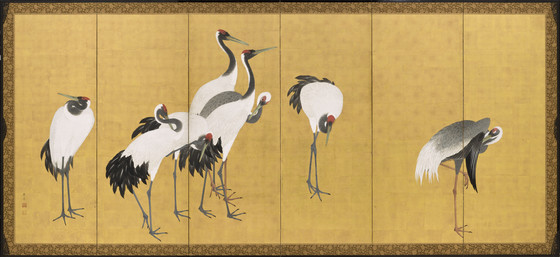Curator Notes
The finest pair of Japanese screens to ever leave Japan in the 440-year history of Western contact with Japan: the most beautiful; the best known; the most unusual; the most published, and the most illustrated in Japanese books, exhibition catalogues, and histories of Japanese art (eight different volumes in all).
By Maruyama Ōkyo, the most revolutionary, the most important, the most celebrated painter in the history of Japanese art in the last 400 years. Of his five most famous pairs of screens, four are Registered National Treasures by the Government of Japan, and may therefore never leave Japan, except on loan; only these legendary Crane Screens remain unregistered, and after a two-year campaign by LACMA’s Curator of Japanese Art, Robert Singer, on February 22, 2011, the Ministry of Culture of Japan granted an Official Export License to LACMA, and only to LACMA, for the right/opportunity to acquire these screens. This Export License can be used by no other person or individual: it is restricted solely to LACMA. This honor was granted in recognition of the growing importance of LACMA’s Pavilion for Japanese Art and its collections, and in the hope (in the words of Professor Sasaki, Director of Kyoto National Museum) that Americans and Europeans can thereby appreciate the very highest achievement in the history of Japanese painting, hitherto not known or seen in any other American or European collection of Japanese art. In other words, when LACMA acquires this pair of screens, they will reign supreme, even when compared to other Japanese screens in the collections of the Boston Museum of Fine Arts, theMetropolitan Museum of Art in New York, the Freer Museum in Washington, D.C., the Cleveland Museum of Art, the British Museum, or any other museum or private collection outside of Japan.
Painted in 1772, and secretly preserved thereafter in only two private collections: the Yamada Collection (1773-1926), and the Inui Collection (1926-present).
Due to their extraordinary collection history, and to their only being shown in public exhibitions twice in their entire 240-year history (for six weeks in 1996 at the Kyoto University Museum of Art, and for six weeks in 2004 at the Osaka Museum of Art), this pair of screens is in astonishing condition, almost without parallel for paintings in mineral pigment on paper created 240 years ago. Other than their twelve weeks on public display in 1996 and 2004, they have been seen in private viewings only by the Emperor Showa (Hirohito) in 1956, and by the present Emperor (Akihito) in 1958, when each Emperor visited the legendary Inui Estate in Kobe to view these screens. These two Imperial Visits are recorded in family photographs, and in a published history, of the Inui Family.
These screens were offered to LACMA, and only to LACMA, personally by the present owner, Mr. Yoshiaki Inui, whose grandfather bought them in 1926 for the then astounding price of ¥16,300 (roughly $16 million today).
There are records from the 1770s that the two species of cranes (Red-crowned and gray cranes) shown in these screens, foraged together, peacefully, on the grounds of the Imperial Palace (Gosho) at that time. Maruyama Ōkyo is pivotal in Japanese art history for being one of the first artists, and certainly the most important artist, to paint directly from nature, rather than from paintings and sketches provided by one’s teacher. The scene depicted here can therefore be seen as based on Jikkei (actual scenes) that Ōkyo observed on the grounds of the Imperial Palace, and that he then harmonized and re-arranged into the breath-taking composition seen here, spread over twenty-six feet of gold leaf.
The crane is a symbol of good fortune and long life in Japanese culture. The Red-crowned Crane, in particular, is an auspicious symbol of the New Year, of peace, harmony, prosperity, and fidelity. Indeed, it may be considered the ultimate symbol of Japan, where it is traditionally thought to live for 1,000 years.
I have been “on the trail” of these paintings for fifteen years, since 1996, at the time of their first exhbition to the public at that time, at Kyoto University Museum of Art. After their owner, Professor Inui, one of my professors at Kyoto University where I was a graduate student from 1973 to 1988, disclosed to me in 2009 that he was their owner, and that he was offering them to LACMA, and only to LACMA, I have worked to acquire them for LACMA, and to obtain a Japanese Government Export License for their shipment to LACMA, which many people said would be impossible, given their fame, their importance, their beauty, their superb condition, and their sheer excellence. The official Japanese Government Export License was granted to LACMA on February 22, 2011.
The pair of screens together measure six feet in height, twenty-six feet in total length. Depicted are seventeen cranes, twelve of one species (Red-crowned cranes), five of another (nabezuru, in Japanese), shown resting, sleeping, nestling, flirting, peering into the distance. Much copied by later Japanese artists, these paintings were revolutionary at the time Ōkyo painted them in 1772: there is no ground plane, no water or streams, no rocks, no vegetation of any kind. These paintings literally changed the course of Japanese art history. They consist simply of seventeen near-life-size cranes against a solid background of pure gold-leaf. Meticulously painted in the finest detail, each crane possesses its own character, personality, and feeling. This pair of screens is unique in the history of Japanese art, and will stand forever as one of the finest objects of Japanese art in existence, and as the finest Japanese screens in any collection outside of Japan, bar none. (Robert Singer, Curator Japanese Art)
More...



